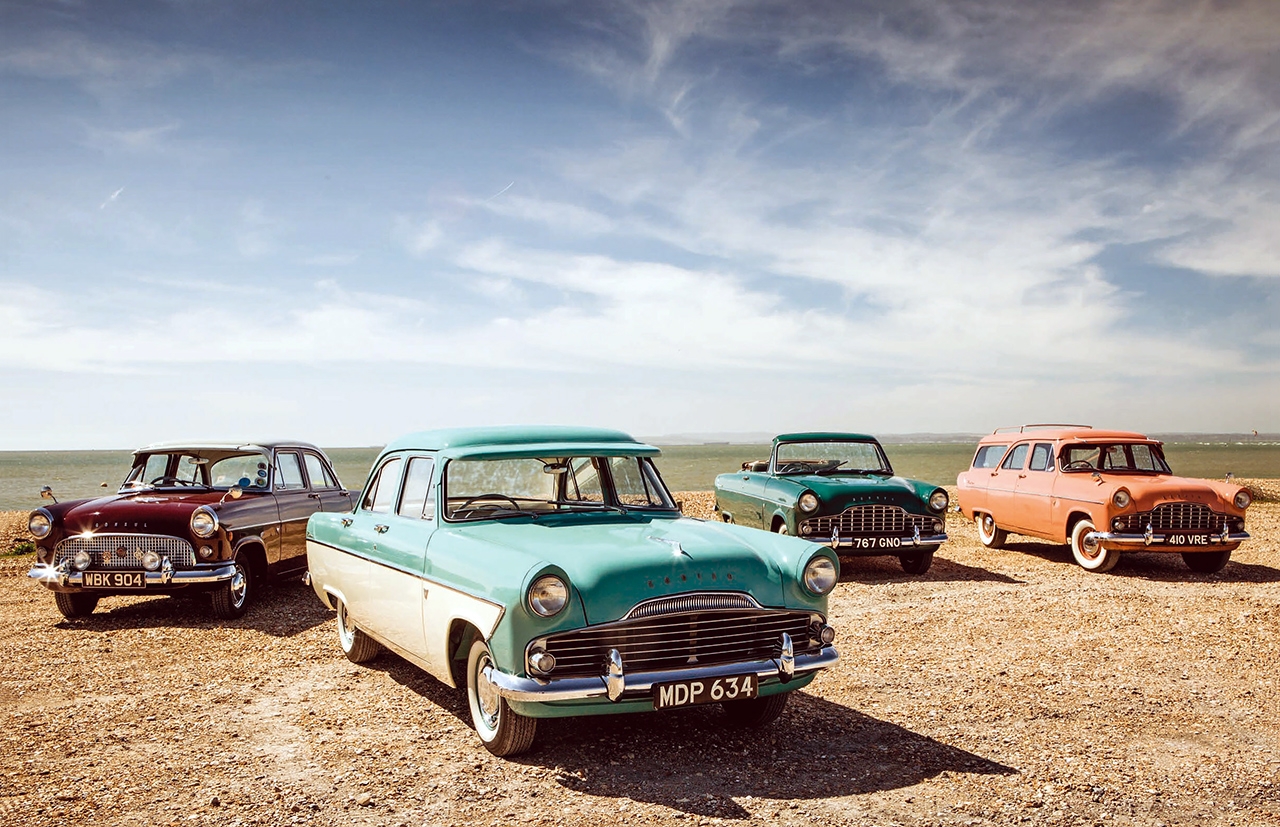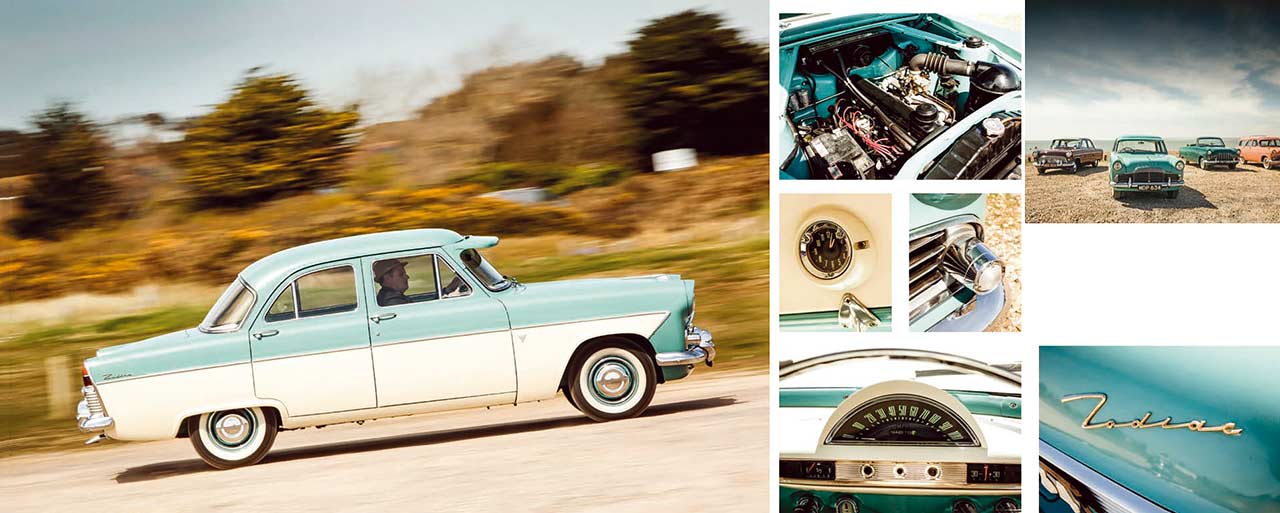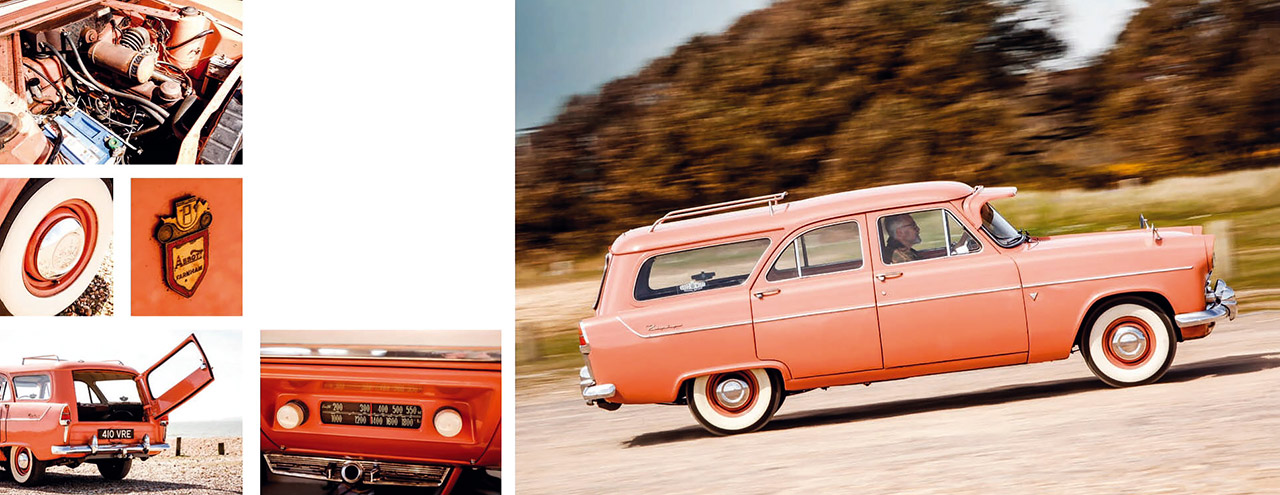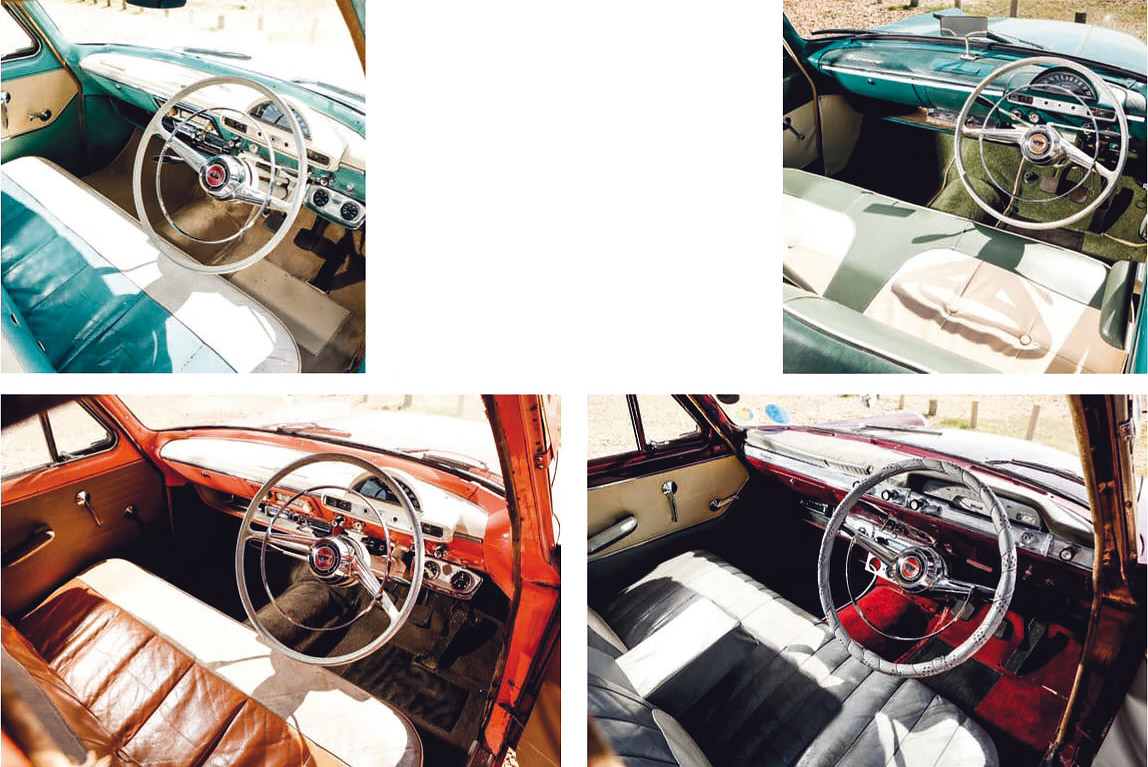
Glamorous family Fords Zephyr, Zodiac & Consul. Ford’s ‘Three Graces’ Celebrating 60 years of the Mk2 Zephyr, Zodiac and Consul. Ford’s rock ’n’ roll facelift. As the Zephyr, Zodiac and Consul Mk2 family celebrates its 60th birthday, Andrew Roberts looks at this very British take on ’50s Americana. Photography Tony Baker.
Sixty years ago, there was a common phrase that ran along the lines of: “What are things coming to?” Ranking high among the social ills of the day – excessive washboard playing in built-up areas, drapejacketed youths jiving to the sounds of Tommy Steele and The Steelmen – must have been a Ford Zodiac Mk2. The original Zephyr-Zodiac of 1953 was bad enough in its exuberant celebration of consumerism, but this second-generation model was worse. With its vestigial fins and dashing looks, the Ford resembled a mobile espresso bar to the sort of motorist whose role model was Edgar Lustgarten.
But for many drivers, the ‘Three Graces’ – as Dagenham modestly billed its latest offerings – represented a form of affordable Americana, be it a four-cylinder 1.7-litre Consul or the 2.5-litre six-cylinder Zephyr or Zodiac. The engineering was ultra-conventional, but the style was what counted. Ford of Great Britain had taken over Briggs Motor Bodies in 1953, and chief stylist Colin Neale was put in charge of the Mk2’s appearance. The coachwork was slightly reminiscent of the ’1954 Fairlane, with overtones of the ’1956 Lincoln at the rear, and was exceptionally well proportioned – especially in six-cylinder form. Neale’s lines made a contemporary Morris seem awkward, while the E-type Vauxhall, Standard Vanguard Phase III and Austin A90 Westminster all appeared redolent of the first half of the ’50s.

From top: straight-six sits low in the engine bay; roof-mounted clock; indicators are set into chromed pods; early cars had a semicircular speedo on the dash top; gold script for the high-spec model; two tone paint reinforces the Ford’s jukebox-era image.
Throughout 1955, a group of prototypes was subjected to extensive testing across Germany, The Netherlands and Kenya. Production began in January ’1956, with the launch on 21 February. Our featured Zodiac is the flagship model, with leather seats, a roof-mounted clock and a cigar lighter to denote its position. Regarding the British social class structure – never to be underestimated as a marketing tool – the big Ford occupied a fascinatingly ambiguous position.
The styling would have been flamboyant enough to appeal to post-war wide boys turned ‘legitimate businessmen’ (a young Arthur Daley would almost certainly have driven a year-old Zodiac) as well as those early British rock ’n’ rollers who wanted to be ‘an all-round entertainer’.
Who could resist a car where chrome was applied to even the most mundane of switches? One of those controls the ‘speed adjustment’ for the vacuum-operated wipers, a system that Ford remained unaccountably fond of for several years. Not until the Anglia 105E in 1959 would Dagenham make a car with electric wipers.
The early Zodiacs were competitively priced, undercutting the MG Magnette by nearly £100, although it is unlikely that the potential buyer of one would have seriously considered the other.
The BMC car offered a responsive four-cylinder engine and sporting pedigree, whereas with the Ford, the object was to manoeuvre the columnmounted gearlever into second with the minimum of double-declutching and leave it be. With the Zephyr and the Zodiac, there was also the advantage of the 2.5-litre motor that had been conceived after the British government finally abandoned the RAC horsepower rating in 1947.

From top: Zephyr shares its over-square ‘six’ with the Zodiac; EnFo logo on heater housing; neat rear quarter windows drop out of sight; inspired name for a model offering wind-in the- hair motoring; three position hood; uncluttered lines with the top down. 767 GNO / UK
The vehicle taxation system had favoured longstroke designs, but for the six-cylinder Mk2s Ford was free to devise an over-square unit that, in the words of The Motor, provided ‘13% more engine size and 21% more power’ than the Mk1.
Ford claimed that the Zephyr was ‘a motorist’s car’ and, although it and the Zodiac were never sports saloons, an 83mph top speed was highly respectable by the standards of the day.
Of equal importance, the powerplant was durable enough for Dagenham’s export markets in the Commonwealth and, for any would-be Stirling Moss, a £135 Raymond Mays conversion would provide a useful performance boost.
Inside, the seats are wide enough to make the Zodiac a genuine six-seater and are upholstered in shades that bring new dimensions to the term ‘jaunty’. The fascia is devoid of timber; Ford’s objective was not to recreate a headmaster’s study but to bedazzle the occupants with such Detroitinspired wordage as ‘hood’ on the bonnet release.
One indication of just how long ago 1956 can seem is not so much in the thin ’screen pillars but the amount of headroom. This was a car designed for both a sober Homburg and the Sydney Taflerstyle Trilby of a spiv. The cumulative effect of the wide grille and extra brightwork on the rear panel, however, is not so excessive as to deter ambitious young professionals and businessmen who wanted a sense of transatlantic verve. To such drivers, a Humber, Rover or Wolseley represented the values of another generation.
The Ford, by contrast, anticipated a future of motels, Formica kitchens and telephones that didn’t need the operator to assist with a trunk call. The next member of our quartet is a car that would have almost certainly have been regarded as symptomatic of what things were coming to in those days. A Zephyr estate finished in Coral, it must have looked downright frivolous, the whitewall tyres representing a further affront to all that was decent and above board. ED Abbott of Farnham had also converted the Mk1, but the extra length of the Mk2 enabled it to create a station wagon with a certain degree of panache.
The saloon origins are immediately apparent, but Abbott had created a vehicle far removed from utilities that were little more than converted vans. The Farnham dared to imply that a practical and capacious car – Ford claimed that maximum load space was 66cu ft – need not lack glamour.
Finished saloon shells were dispatched to Surrey, where the coachbuilder extended the roofline and used the original boot sill to produce the new body. A side-opening rear door – hinged on the offside – completed the conversion. About 5600 estates were sold via Ford dealerships, a few of which famously entered service as Britain’s first-ever motorway patrol car. Lancashire Constabulary used Farnhams to police the eight-mile Preston bypass in 1958 and, when the first stretch of the M1 opened in November ’1959, forces in five counties adopted Zephyr estates.
Finished in pink, ‘ours’ may look as though it has strayed from a home furniture catalogue, but the model was instrumental in saving many lives. Ford regularly updated the line-up, with the option of Borg-Warner automatic transmission, a new grille for the Zephyr in ’1958 and, in February ’1959, a minor facelift that included the roof being lowered by some 1½in to create the Lowline.
Aesthetic judgements vary as to the merits of the later version against the earlier Highline, but this Consul is certainly rather dapper. It also has a more sensible speedo (which glows green when illuminated) in place of the previous half-moon dial, as well as more comfortable bench seats than the stylish but flat cushions of the Zodiac.

From top: 2553cc ‘six’ was good for 83mph; whitewalls suit the car well; coachbuilder’s plaque; side-hinged rear door; lovely period radio; saloon origins are evident in the shape of the C-pillar, but the Farnham estate is a very handsome design. 410 VRE / UK
The Consul was designed with fleet buyers in mind, and any picture of a provincial British town of the late ’50s or early ’60s is bound to feature at least one outside a pre-Beeching railway station. From 1961 onwards, the Consul gained a ‘375’ suffix in order to distinguish it from the new Consul-Classic 315. The later models could be specified in De Luxe guise, which was virtually a four-cylinder Zodiac – complete with hide trim and windscreen washers as standard. This was the car that commercial travellers aspired to as they peddled fish fingers to the supermarkets in their sales territory.
Finally, there is the magnificent Convertible. The Mk1 Consul and Zephyr had been available with a drophead conversion by Carbodies of Coventry and the Mk2 would be offered in this form, too – partly because of the enthusiasm of Sir Patrick Hennessy, the then-chairman of Ford GB. For the first time, there would also be a Zodiac version that, like the Zephyr, boasted a semi-power top that retracted from the coupé de ville position at the push of a button. ‘Ours’ is one of the very first, though, so has a manual hood.
Naturally I lowered the roof and windows before setting off, because there is simply no other way to experience the Zephyr. The brochure for the saloon promised that ‘heads will turn as you drive past’, so I was curious to learn whether this would be the case with the Convertible. As it transpired, there was indeed a considerable reaction and quite an array of comments, ranging from “What is it?” to “I’d like that for my prom”.
Better still, the Zephyr is a very agreeable form of transport, especially over coastal roads that are not entirely free of potholes – the weight of the coachwork and the long suspension travel more than compensate for any deficiencies in the tarmac. My first impression is of the vastness of the thin-rimmed wheel, but it proved essential to compensate for the sheer weight of the worm-and- peg system at low speeds. When cruising in second, though, the Ford comes into its own, the steering gaining a genuine lightness of touch.
A Zephyr Convertible is emphatically a five as opposed to a six-seater, because the hood mechanism robs the rear bench of space. The front seat, meanwhile, suffers from a comparative lack of fore and aft adjustment but these are minor points. The Ford’s raison d’être is to make you temporarily believe that you are en route to Lake Tahoe, as opposed to Stoke Poges.
Some 1950s column changes make you wonder whether the engineer responsible was exacting a revenge upon society – I still have nightmares about BMC’s four-speed system – but the Ford three-on-the-tree feels positive in operation. Bottom is devoid of synchromesh but the transmission functions very well as a two-speed – there is more than enough torque for the Zephyr to amble along at 20mph in top. This facility for low-speed driving was one reason why the Convertible was ideal for provincial beauty pageants. In local newspaper archives, you are bound to see black-and-white photos of Miss Hedge End Bakery 1958 or Miss Woolworth (Yeovil) 1959 in the back of a drophead Ford.

From top: 1.7-litre ‘four’ in the lower-spec version; neat hubcaps; front bench has a drop-down centre armrest; stylish script on bootlid; this car has the later-type fascia; Consul has less chrome than its siblings but still manages to turn heads today. WBK 904 / UK / Ford Consul Mk2 1.7
By modern standards the clutch feels heavy but, for a car made six decades ago, it is smooth to operate. The exhaust note is quite prominent in town, but once we’re cruising the only sounds are the purring of the engine, various irate seagulls and those comments from passers-by. Stopping power is courtesy of drums – front discs were not an option on the Mk2 until 1960 – but they are sufficient to cope with modern traffic. Best of all, after a mere jab on the pedal we are in 77 Sunset Strip territory, albeit Hampshire fashion, or in the murky realm of the post-war British crime film. Several low-rent producers favoured the Zephyr Convertible as a cheap alternative to a Yank, but sadly there’s not sufficient time in which to re-enact scenes from The Long Haul or the brilliantly awful Crossroads to Crime.
Production of the Mk2 ceased in April ’1962 after a hugely successful six-year run. From 1954-’1958, production of British Fords had doubled, and much of that was due to the Three Graces. Food rationing had ceased less than 20 months before their debut, but these cars were far removed from the ethos of shortages, darning and queuing in the rain. They offered US-style aspiration on a scale that would not overly appal suburbia, even if some neighbours may have regarded excess chrome as the end of civilisation. When John Lennon first met Brian Epstein in 1961, his sense of middle-class values was reassured by the latter’s Zodiac: smart, slick but never flash. Or, as Ford put it ‘swift, sure luxury’.
Thanks to John Deverell, Paul Atkinson, Dave Smith
US influence
The 1950s were Detroit’s golden age and today the cars are rightly revered as icons of a lost era. Annual redesigns led to the rapid evolution of the styling theme, taking cars from being curvaceously organic to sharpedged rocket ships sporting outrageous embellishment.

Inspired by the dawn of the jet-age and the nascent space race, the likes of Harley Earl and Virgil Exner penned ever more extravagant shapes that progressively became longer, lower and wider. Everything from bonnet mascots to overriders to steering wheel bosses morphed into chrome-laden missiles, while improved manufacturing techniques also encouraged the use of complex curved glass. Most emblematic of the era, though, is the tailfin. First seen on the ’1948 Cadillac (top), by 1959 they’d reached vast dimensions – sometimes at the price of significant lift. By 1960 it was all over, and such excess has never been seen since.
‘ITS RAISON D’ÊTRE IS TO MAKE TO YOU BELIEVE THAT YOU’RE EN ROUTE TO LAKE TAHOE, RATHER THAN STOKE POGES’
TECHNICAL DATA FORD ZODIAC Mk2
Sold/number built 1956-’1962/301,417 (including Zephyr)
Construction steel monocoque
Engine all-iron, overhead-valve, 2553cc inline-six; single Zenith carburettor
Max power 85bhp @ 4440rpm
Max torque 133lb ft @ 2000rpm
Transmission three-speed manual, synchro on second and top, optional overdrive, RWD
Suspension: front independent, by MacPherson struts, anti-roll bar rear live axle, semi-elliptic springs, lever-arm dampers
Steering worm and peg (recirculating ball from 1957 onwards)
Brakes hydraulic drums (optional servoassisted discs/drums from Sept ’1960)
Length 15ft ½ in (4585mm)
Width 5ft 7in (1702mm)
Height 5ft 1 7/8 in (1572mm)
Weight 2891lb (1311kg)
0-60mph 20.9 secs
Top speed 83mph
Price new £968 17s
Price now £17,000
TECHNICAL DATA FORD ZEPHYR CONVERTIBLE (Where different)
Weight 2800lb (1270kg)
0-60mph 17 secs
Top speed 88mph
Price new £1090
Now £20,000
TECHNICAL DATA FORD ZEPHYR FARNHAM ESTATE (Where different)
Number built 5643 (all Mk2s)
Weight 2838lb (1287kg)
0-60mph 18.7 secs
Price new £1010
Now £25,000
TECHNICAL DATA FORD CONSUL DELUXE (Where different)
Number built 380,983
Engine all-iron, overhead-valve, 1702cc ‘four’
Max power 59bhp @ 4400rpm
Max torque 91lb ft @ 2300rpm
Length 14ft 4 ½ in (4382mm)
Weight 2492 lb (1116kg)
0-60mph 29 secs
Top speed 75mph
Price new £822 15s 10d
Now £10,000

Stylish and capacious duo-tone interiors of the (clockwise, from left) Zodiac, Zephyr Convertible, Consul and Farnham estate are pure ’50s Americana, albeit on a rather smaller scale.
‘FORD’S OBJECTIVE WASN’T TO RECREATE A HEADMASTER’S STUDY, BUT TO BEDAZZLE THE CAR’S OCCUPANTS’





